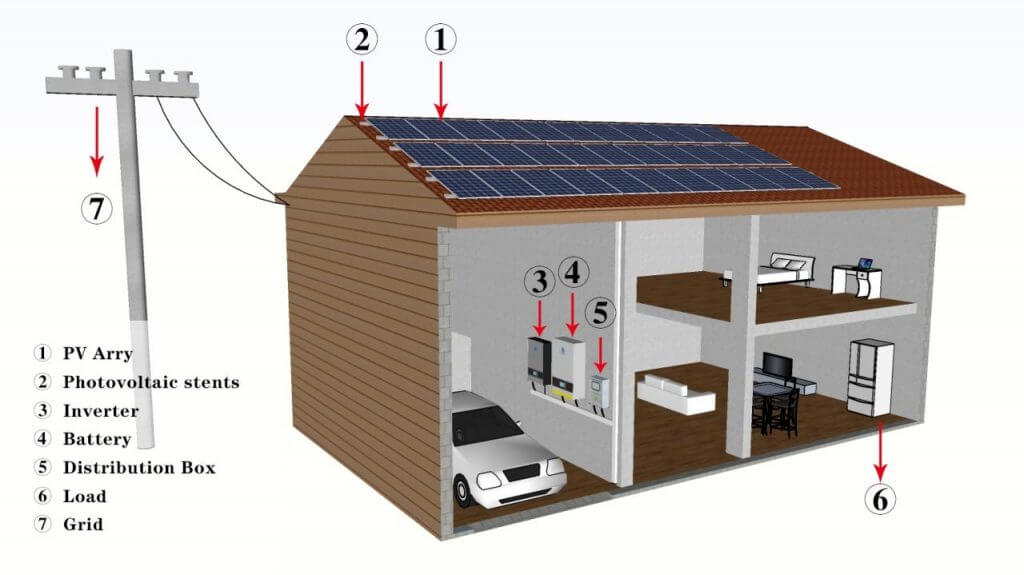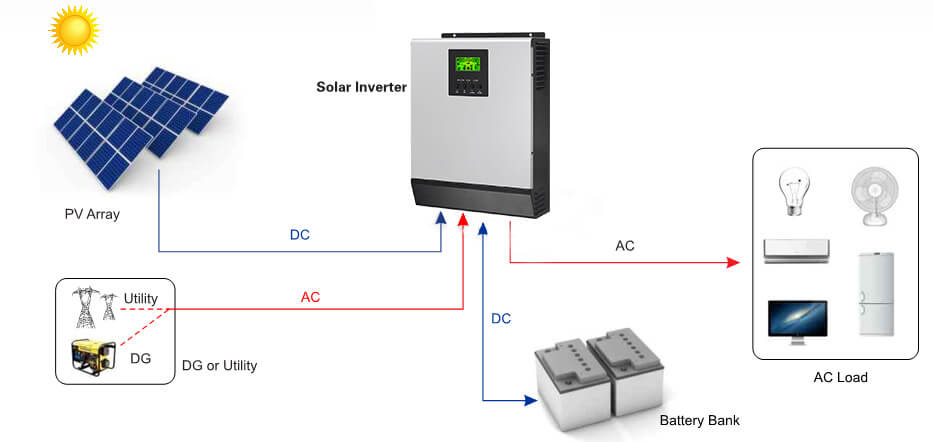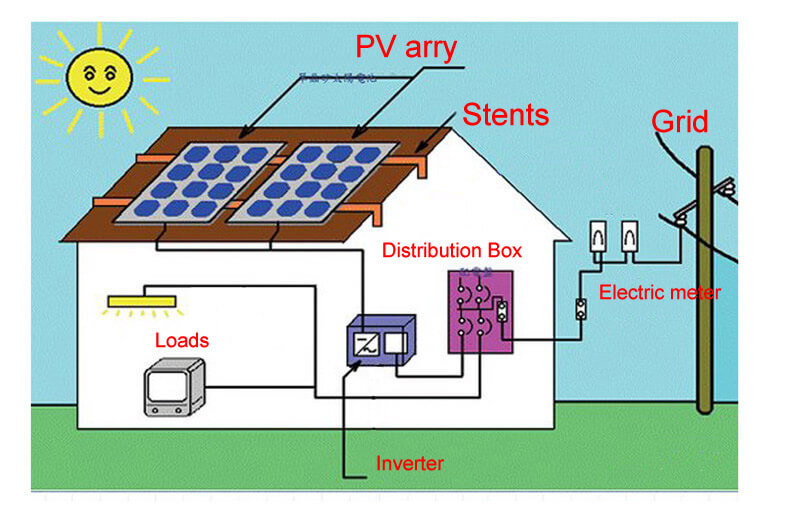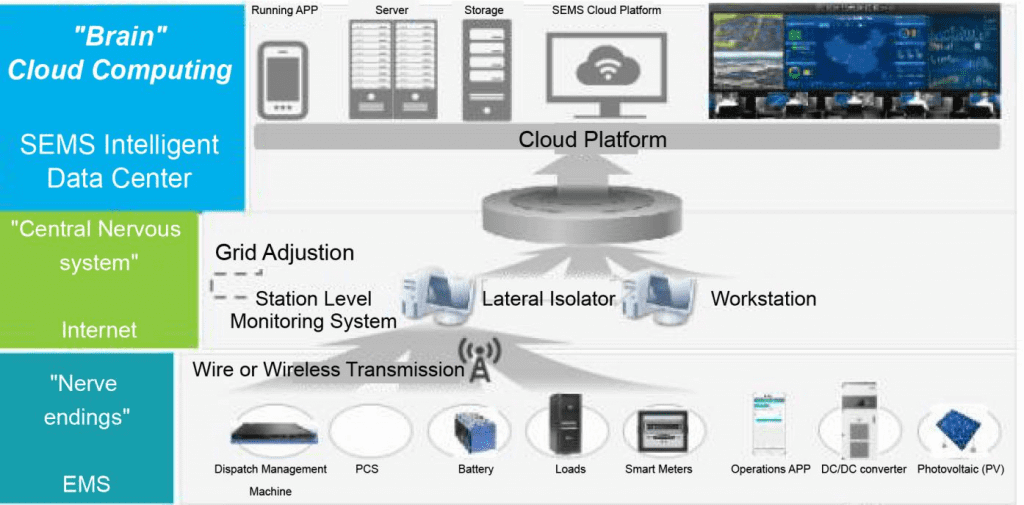Home » Solar Power System » how to build a solar power system tutorial
How to build a solar power system tutorial
What forms a complete solar power system?

In general, a photovoltaic DC side container type energy storage system is mainly composed of solar cell module, DC / DC converter, lithium iron phosphate(IIP) battery unit battery management system, energy storage converter PCS (including isolation transformer), photovoltaic lightning protection combiner box and battery bus cabinet, energy management system(EMS), bracket, cable and electrical protection unit, monitoring system, lightning protection grounding system, etc..
Now, in this article, I’ll show you how to design a photovoltaic DC side container type energy storage system through a real project that we have done for a factory with abundant sunshine resources. And the solar power system structure diagram is shown below
- General Design Description of Solar Power System Project?
- Solar power system design principles and basis
- Solar power system design Ideas
- Solar Power System Operation Mode
- Design the Photovoltaic(PV) Power Supply System
- Design of the Energy Storage System
- Design of Intelligent Power Distribution System
- Design of the Energy Management System
Chapter 1: General Design Description of Solar Power System Project
According to the actual needs of customers, the project uses energy storage technology on the side of photovoltaic power station to solve the problem of “light abandonment” of the power station, promote the absorption of renewable energy, and realize the functions of smoothing power fluctuation, peak shaving and valley smoothing, load tracking, frequency regulation and voltage regulation, etc.
Therefore, the project is planned to design a set of containerized energy storage system configured at the DC side of power supply.
When photovoltaic DC side container energy storage system encounters the limit of abandoned light power generation, the excess energy is stored in the energy storage battery pack. When the photovoltaic power generation is lower than the limit or during the peak period, the energy in the battery is transmitted to the grid through the energy storage converter to participate in the peak load cutting and valley filling of the grid, and the peak valley price difference is used to create better economic benefits, so as to improve the regulation efficiency of the system ability.
The photovoltaic DC side container energy storage system of this project, which adopts the working mode of parallel and off grid operation, is mainly composed of solar power system, energy storage system and low-voltage distribution system and to provide power to users through low-voltage AC distribution system. As a controllable power system unit, the system can smooth power output, optimize power flow, reduce feeder loss, respond to the needs of users, and greatly improve the reliability and stability of power supply.
Chapter 2: Solar power system design principles and basis
Here are some principles and basis that you need to know before start designing.
- Solar power System design principles
(1) safe and stable operation;
(2) highest energy efficiency of the system;
(3) The system design conforms to the relevant national design standards;
(4) system economic operation.
- Solar power system design basis
(1) GB 21966-2008 Safety of primary and secondary lithium cells and batteries during transport
(2) GJB 4477-2002 General specification for Li-ion batteries
(3) QC/T 743-2006 Lithium-ion batteries for electric vehicles
(4) GB/T 12325-2008 Power quality-Deviation of supply voltage
(5) GB/T 12326-2008 Power quality-Voltage fluctuation and flicker
(6) GB/T 14549-1993 Quality of electric energy supply-Harmonics in public supply network
(7) GB/T 15543-2008 Power quality-Three-phase voltage unbalance
(8) GB/T 2297-1989 Terminology for solar photovoltaic energy system
(9) DL/T 527-2002 Technical condition for power supply at static state protection equipment
(10) GB/T 13384-2008 General specifications for packing of mechanical and electrical product
(11) GB/T 14537-1993 Shock and bump tests on measuring relays and protection equipment
(12) GB/T 14598.27-2008 Measuring relays and protection equipment-Part 27: Product safety requirements
(13) DL/T 478-2001 General specifications for static protection, security and automatic equipment
(14) GB/T 17626 -2006 Electromagnetic compatibility – Testing and measurement techniques
(15) GB 14048.1-2006 Low-voltage switchgear and controlgear-Part 1: General rules
(16) GB 7947-2006 Basic and safety principles for man-machine interface, marking and identification-Identification of conductors by colours or numerals
(17) GB 8702-88 Regulations for electromagnetic radiation protection
(18) DL/T 5429-2009 Technical code of design for the electric power system
(19) DL/T 5136-2001 Technical code for designing of electrical secondary wiring in fossil fuel power plants and substations
(20) DL/T 620-1997 Overvoltage protection and insulation coordination for AC electrical installations
(21) DL/T 621-1997 Grounding for AC electrical installations
(22) GB 50217-2007 Code for design of cables of electrical engineering
(23) GB 2900.11-1988 Terminology of (secondary) cell or battery
(24) IEC 61427-2005 Secondary cells and batteries for photovoltaic energy systems – General requirements and methods of test
(25) Q/GDW 564-2010 Technical guideline for electric energy storage system interconnecting to distribution network
(26) QC/T 743-2006 Lithium-ion batteries for electric road vehicles
(27) GB/T 18479-2001 Terrestrial photovoltaic(PV) power generating systems – General and guide
(28) GB/T 19939-2005 Technical requirements for grid connection of PV system
(29) GB/T 20046-2006 Photovoltaic(PV) systems – Characteristics of the utility interface
(30) GB 2894 Safety signs( neq ISO 3864 :1984)
(31) GB 16179 Guidelines for the use of safety signs
(32) GB/T 17883 Alternating current static watt-hour meters for active energy (classes 0.2S and 0.5S)
(33) DL/T 448 Technical administrative code of electric energy metering
(34) DL/T 614 Multifunction electricity metering equipment (A.C.)
(35) DL/T 645 Multi-function watt-hour meter communication protocol
(36) DL/T 5202 Technical code for designing of electric energy metering system
(37) SJ/T 11127 Overvoltage protection for photovoltaic (PV) power generating systems – Guide
(38) IEC 61000-4-30 Electromagnetic compatibility – Part 4-30: Testing and measurement techniques – Power quality measurement methods
(39) IEC 60364-7-712 Low voltage electrical installations – Part 7-712: Requirements for special installations of locations – Solar photovoltaic (PV) power supply systems
Chapter 3: Solar power system design Ideas
Overall, the project is designed according to four systems:
(1) solar power system (including PV module, DC / DC converter);
(2) Energy storage system (including energy storage unit, energy storage converter PCS);
(3) Intelligent power distribution system (including low voltage switch cabinet);
(4) Energy management system (including EMS energy management, BMS battery management, communication cabinet).
I will introduce them for you one by one in the following chapter 5-8, especially the energy storage system.
Chapter 4: Solar Power System Operation Mode
The project is a medium-sized photovoltaic(PV) DC side container energy storage system, which is connected with the electric supply, and forms a set of comprehensive energy complementary application system.
The specific operation mode is as follows:
(1)When the electric supply is normal, the system is in-grid operation mode.
When the sunlight is sufficient in the daytime, the PV array converts solar energy into electric energy, and directly charges the battery pack through MPPT charging controller. When the power consumption is in peak period, it is converted into three-phase AC with voltage level of 0.4kV through energy storage converter PCs to supply power to the user load;
At this time, the battery is completely dependent on the PV power generation of the system, and the power of the grid can not charge the battery.
(2)When the electric supply is out-of-order or interrupt, the system is off-grid operation mode.
As the PV energy is weak in the early morning, the PV system and energy storage system supply power to the user load at the same time;
In the morning and noon, the light will get stronger, the energy of PV system meets the user load first, then the surplus energy is stored in the battery pack;
After sunset, the PV system energy will disappear, the energy storage takes the function of providing electricity to the user load at this time.
Chapter 5: Design the Photovoltaic(PV) Power Supply System
The project is located in a factory with abundant sunshine resources, so it needs to take daily power consumption of users, system conversion efficiency, inverter efficiency and peak sunshine time into consideration.
As the local sunshine resources are rich, the design of PV power supply system can make full use of abundant sunshine resources, and store the surplus electric energy with the energy storage system.
When the PV power generation is lower than the limit amplitude or during the peak period of electricity consumption, the energy in the battery is transmitted to the grid through the energy storage converter to participate in peak shaving and valley filling of the power grid, so as to create better economic benefits by using the difference between peak-valley prices, contributing in improve the regulation ability of the whole system itself.
Chapter 6: Design of the Energy Storage System
The energy storage system, which needs to be based on the total load power and load working characteristics of users, is mainly composed of lithium-ion phosphate battery and energy storage converter PCS.
After comprehensive consideration of this system, the project is based on lithium iron phosphate battery energy storage technology, which the actual power consumption and energy storage system, as well as the comprehensive efficiency of energy storage system should be considered, aiming to facilitate transportation and installation and reduce the floor space.
The energy storage system is mainly composed of lithium iron phosphate battery unit, DC BUS unit, battery management system (BMS), energy storage converter (including isolation transformer) (PCS), container body (including power distribution), energy management system (EMS), monitoring system, automatic fire control system and temperature control system, etc.
The specific functions of each part above will be introduced in the energy storage system(), here is a brief introduction.
Chapter 7: Design of Intelligent Power Distribution System
Intelligent distribution system is a set of power management system which is secondary developed according to the needs of users and following the standards and specifications of distribution system. It has the characteristics of strong specialty, high automation, easy to use, high performance and high reliability, which is suitable for low-voltage distribution system.
Through telemetry and remote control, the load can be reasonably allocated, the optimal operation can be realized, and the electric energy can be effectively saved, and there are peak and valley power consumption records, thus providing necessary conditions for energy management.
The intelligent power distribution system of the project mainly connects and controls the distributed energy, energy storage unit, large power grid and user load, generally including intelligent circuit breaker, smart meter, etc..
Chapter 8: Design of the Energy Management System
The energy management system is mainly composed of EMS (energy management system), communication line, communication cabinet, communication modules of each subsystem, intelligent switch control interface, etc..
Through the collection and reading of electrical performance parameters such as distributed energy (power, voltage, current), energy storage unit (battery SOC, voltage, current), load (load voltage, current, active power, reactive power, apparent power), power grid (grid switch state, grid current, voltage, active power, reactive power, frequency, power factor), and control the optimal operation of each subsystem according to the preset working mode, in order to achieve high efficiency of new energy utilization maximum.
Based on the relevant principles, I can’t tell you how to design a solar power system through specific data, however, I hope to show the professionalism of our team through the design ideas described in this article. As long as you have needs and contact us, believe that we can give you a satisfactory design scheme.





























4 thoughts on “how to build a solar power system tutorial”
Pingback: how to make solar power energy management system The Best lithium ion battery suppliers | lithium ion battery Manufacturers
GOOD
Pingback: Lithium Ion Motorcraft Battery: A Deception or the Future? The Best lithium ion battery suppliers | lithium ion battery Manufacturers - TYCORUN ENERGY
I like what you guys are usually up too. This kind of clever work and exposure!
Keep up the good works guys I’ve added you guys to my personal blogroll.